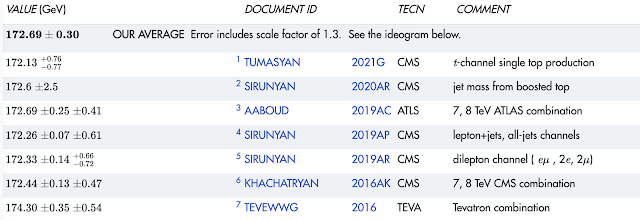A new top quark pole mass measurement from CMS at the Large Hadron Collider (LHC), which appears to use some, but not all, of the Run-2 data from CMS, is the highest of the LHC measurement to date.
So, it will slightly tug up the global average closer to 173 GeV. The precision of the measurement is not bad, but not exceptional or record breaking in isolation.
A measurement of the top quark pole mass m(pole)(t) in events where a top quark-antiquark pair (tt¯) is produced in association with at least one additional jet (tt¯+jet) is presented.
This analysis is performed using proton-proton collision data at s√ = 13 TeV collected by the CMS experiment at the CERN LHC, corresponding to a total integrated luminosity of 36.3 fb−1. Events with two opposite-sign leptons in the final state (ee, μμ, eμ) are analyzed. The reconstruction of the main observable and the event classification are optimized using multivariate analysis techniques based on machine learning. The production cross section is measured as a function of the inverse of the invariant mass of the tt¯+jet system at the parton level using a maximum likelihood unfolding.
Given a reference parton distribution function (PDF), the top quark pole mass is extracted using the theoretical predictions at next-to-leading order. For the ABMP16NLO PDF, this results in m(pole)(t) = 172.94 ± 1.37 GeV.
CMS Collaboration, "Measurement of the top quark pole mass using tt¯+jet events in the dilepton final state in proton-proton collisions at s√ = 13 TeV" arXiv:2207.02270 (July 5, 2022).
This is a direct measurement. The Particle Data Group global averages are:
t-Quark Mass (Direct Measurements) 172.69±0.30 GeV (S = 1.3)
t-Quark Pole Mass from Cross-Section Measurements 172.5±0.7 GeV
The PDG direct measurement average is based upon:
The PDG cross-section average show more scatter, in part due to lower precision, and are based upon the following data:


No comments:
Post a Comment